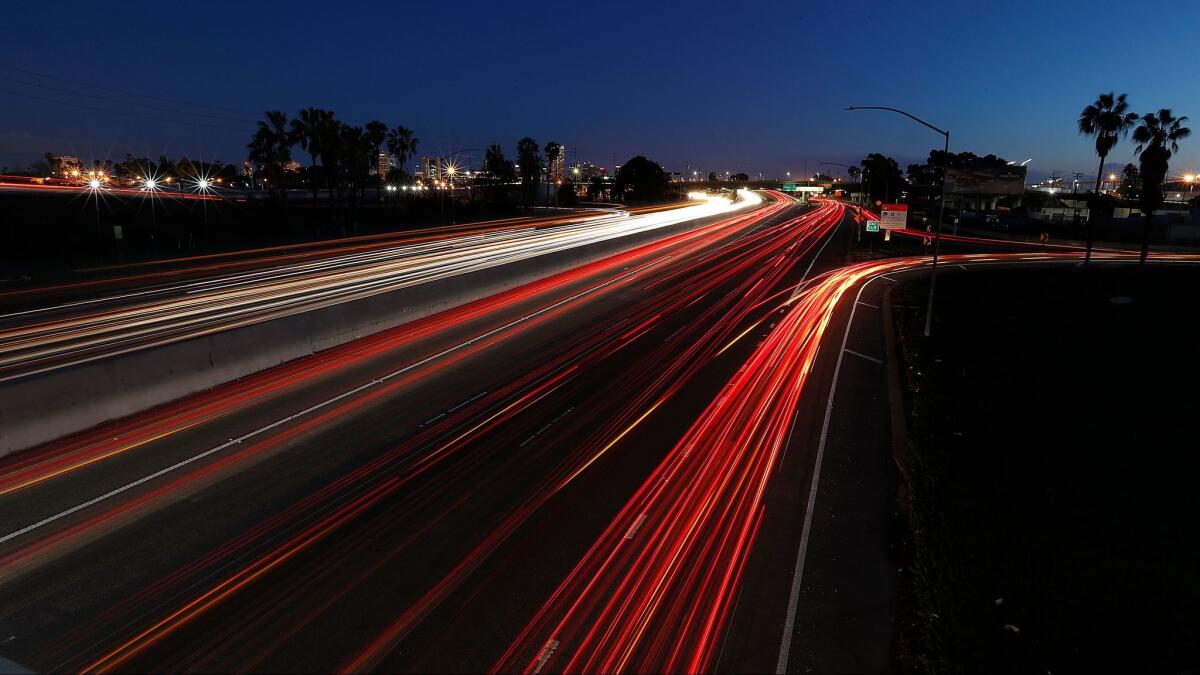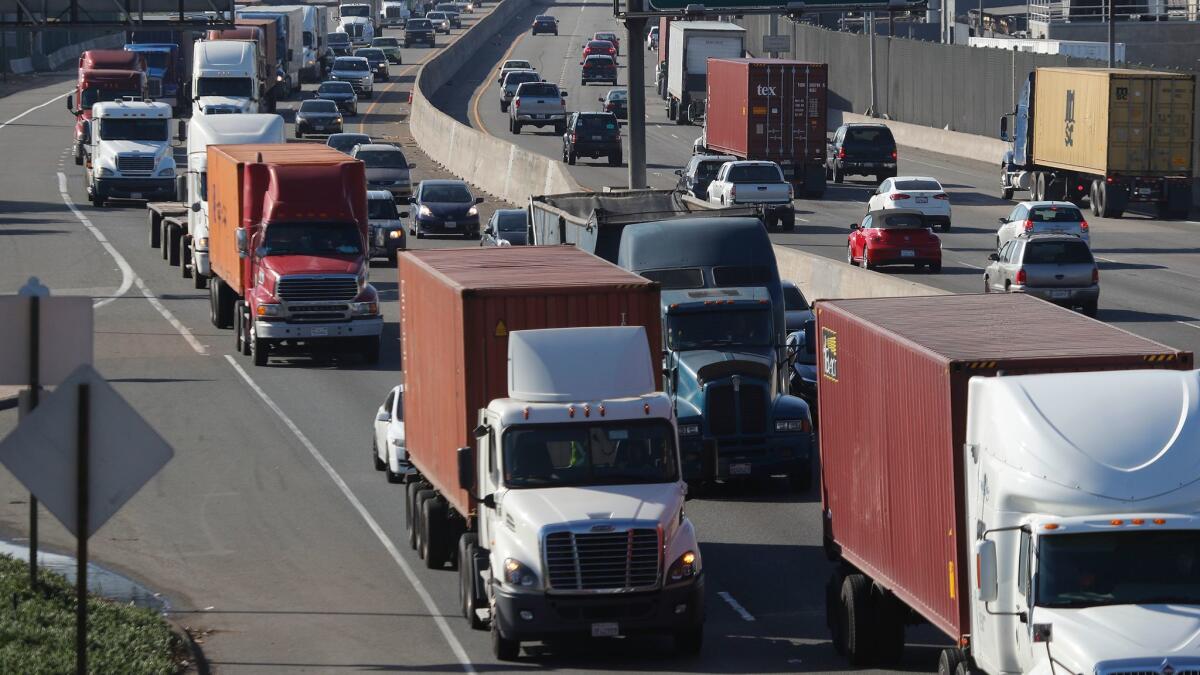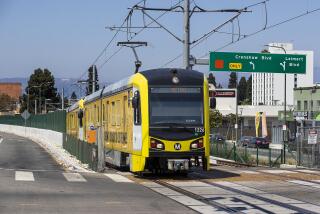710 Freeway is a ‘diesel death zone’ to neighbors — can vital commerce route be fixed?

For decades, the 710 Freeway has been the commercial spine of Southern California, funneling the trucks carrying thousands of tons of furniture, clothes, televisions and other goods from the ports of Los Angeles and Long Beach into the region’s sprawling network of freeways and warehouses.
But the steady stream of freight traffic on the 710, driven by the country’s growing appetite for imported goods and two-day shipping, has taken its toll. The pavement is cracked, bottlenecks are common, and the share of trucks on the freeway is three times higher than engineers in the 1960s expected.
Transportation officials have clashed for decades with local and environmental advocates over how to untangle traffic and speed the movement of goods along the 710 without further harming the surrounding neighborhoods that lie in what’s known as “the diesel death zone.”
After all that debate, the Metropolitan Transportation Authority has a chance this week to make a decision. At a downtown board meeting Thursday, the agency’s directors will consider two alternatives to widen the 710, both of which would require evicting hundreds of residents and business owners to make room for new freeway lanes.
Along a corridor that generates so much commerce and pollution, any decision will be controversial. Attempting to stave off that backlash, a coalition of Metro directors says it will propose a compromise that would greenlight some improvements, including longer ramps and new interchanges, but delay a decision on the widening.
Before any major construction could begin, Caltrans and Metro need to close a shortfall of at least $5 billion. Choosing an alternative will help the agencies identify more state and federal funding, officials said.
Both alternatives call for lanes reserved for zero-emission or low-emission trucks. The route, if built, would represent the first leg of a green freight network, possibly including tolls, that planners have envisioned for more than two decades.
The $6-billion alternative backed by Metro staff members would add a lane for zero-emission trucks between Ocean Boulevard in Long Beach and the 60 Freeway in East Los Angeles, and lanes that would allow truckers to bypass traffic backups near the 405 Freeway. The plan would update ramps at 24 streets and rebuild interchanges with the 91, 5 and 405 freeways.
The $10-billion alternative calls for four elevated truck-only lanes parallel to the 710, in addition to similar interchange and ramp improvements.
The amendment introduced this week would require Metro and Caltrans to finish interchange, intersection and ramp improvements along the 710 before seeking approval of the wider route. Depending on funding and construction progress, that could be at least a decade away.
The proposal would also require Metro to further reduce or eliminate the planned displacement of up to 560 residents and business owners along the corridor. More than 90% of the 710 changes can be completed in the existing right-of-way without using eminent domain, the directors said.
The motion would provide grants and other financial incentives for trucking companies to adopt zero-emission engines. It would also urge the use of more rail, particularly “on-dock rail,” which allows the ports to transfer cargo directly from ships to trains. The process can eliminate 750 truck trips for each full train, port estimates show.

County Supervisor Kathryn Barger and other officials have urged a financial model that would push shipping companies toward rail — particularly the nearby Alameda Corridor, a rail expressway from the ports to rail yards near downtown that has unused cargo capacity.
“If we’re going to do financial incentives as it relates to zero emissions, we need to look at financial incentives for rail,” Barger said at a recent Metro meeting.
But loading cargo onto trains, and paying the per-container fee on the Alameda Corridor, makes financial sense only for companies that are sending their goods to another state, said Hasan Ikhrata, executive director of the Southern California Assn. of Governments, a regional planning agency.
Trains do not head north up the corridor until they’re fully loaded, a process that can take hours.
About 37% of cargo entering the ports stays in Southern California, either to be consumed here, or sent to local warehouses to be unpacked, sorted, repacked and sent out on trucks. As more customers expect two-day delivery for online purchases, that form of delivery will only become more dominant, he said.
“For short distances, trucks are the cheapest and the most economic mode there is,” Ikhrata said. “To expect Alameda Corridor to do more than it’s doing now is not going to work.”
Highway officials began to study the problems of the 710 more than two decades ago. In 2003, as cities along the route asked for a fix to their traffic problems, and as officials studied options, advocates learned that up to 1,000 homes and businesses could be demolished to make way for extra freeway lanes. The resulting outcry put the project on pause — but only temporarily.
The idea returned several years later, only to be stymied by a funding shortfall and the worst economic recession since World War II. The project eventually secured enough funding for environmental reviews, guaranteed through two half-cent sales taxes that Los Angeles County voters approved in 2008 and 2016.
Caltrans and Metro officials eventually reduced by half the number of people who would lose their homes and businesses. They now estimate that the $6-billion project would displace 436 people, and the $10-billion option would displace 484 people.
“When I saw those numbers, I thought, ‘Oh no, not this again,’” said Alan Hose, a Long Beach resident who served on a 710 advisory committee in 2004. The group of concerned residents, environmentalists and others had pushed Caltrans and Metro to design the freeway without displacing anyone. Officials say that is impossible.
Still, the number of people who would be forced to move remains a sticking point on the project. Immigrants living in the country illegally would not be eligible for federal relocation benefits, advocates said.
At a recent Metro meeting, Los Angeles City Councilman and Metro director Mike Bonin described the figures as “scary high.” Evictions could permanently alter the rhythm of life for communities near the freeway, he said, as they did for neighborhoods near Los Angeles International Airport.
“I can still see people talking about the homes taken away to accommodate LAX expansion decades ago,” Bonin said. “Folks still talk about the folks who lost their homes in Chavez Ravine. It haunts and scars an area for a long time.”
Advocates for the southern half of the 710 have said that they feel they’ve been treated differently from the preservation and environmental advocates who battled a proposed 4.5-mile extension of the northern half of the 710.
The northern project would have redirected the hundreds of trucks that spill onto surface streets in Alhambra at the freeway’s abrupt ending, but would have required building through, or tunneling under, hundreds of single-family homes in El Sereno, Pasadena and South Pasadena.
The ugly, decades-long fight ended last year when Metro dropped its support for the project, agreed not to fund any major construction on it, and redirected the funds to local street improvements.
“This is not the kind of response that happened when the folks up in South Pasadena had questions about freeway development — a radically different neighborhood,” said Long Beach resident Leanne Noble at a Metro meeting last month. “Our neighborhoods also have the right to stability and to health.”
Twitter: @laura_nelson
More to Read
Sign up for Essential California
The most important California stories and recommendations in your inbox every morning.
You may occasionally receive promotional content from the Los Angeles Times.











